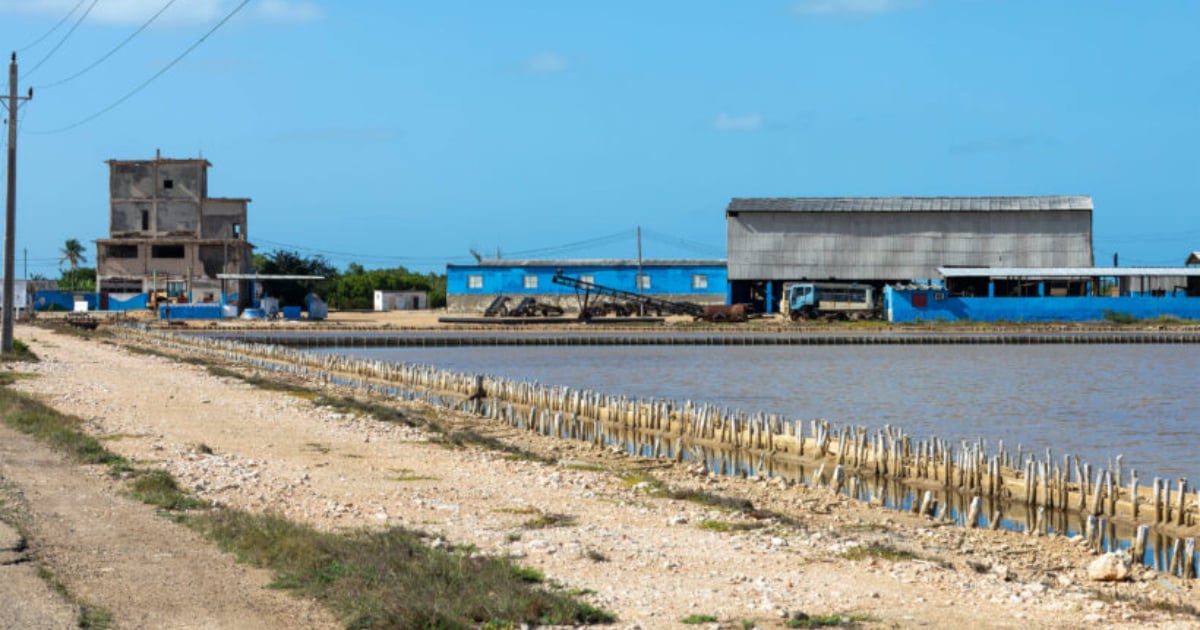
Related videos:
The salt production in Matanzas is in a critical state. The base business unit (UEB) Salinera Matanzas, located in the Martí municipality, has been unable to maintain a stable production cycle for over a year, according to a report from the official newspaper Girón. The pumps that extract seawater are out of service, the machines are corroded by salt, and the plant's infrastructure is deteriorating due to the lack of basic materials.
The company’s director, Blas Jesús Hernández Santos, acknowledged that the saltworks produces only between 1,000 and 4,000 tons annually, a fraction of what it generated in past decades. In 2024, the entity lost six million pesos due to heavy rains that ruined several tons that had already been harvested.
The brine has become contaminated due to prolonged inactivity and lack of water circulation. Power outages prevent the pumping and maintenance of the evaporation and crystallization ponds, which halts the natural process of salt extraction. "The pumping system is over 15 years old, and we are trying to salvage it on our own," said the executive.
Without the minimum resources to operate—no paint to protect structures, no gases to shape or weld damaged parts—the production relies on manual labor. For the past two years, workers have been loading salt into wheelbarrows due to the inability to use the harvester, which has been out of service for a long time. Some key components of the plant have been transferred to other provinces to address urgent needs in facilities with higher state priority.
The workers are keeping production going under extreme conditions. Only 14 young people make up the current workforce, which consists of over a hundred individuals, many of whom have been with the company for more than 20 years. Alternative production lines (such as calcium sulfate for white cement or industrial talc) are operating on a small scale.
National salt shortage: an extended crisis
The situation in Matanzas is not an isolated case. In Artemisa, more than 450,000 people have gone months without receiving salt for the basic basket, while in Havana the rations for June and July were only distributed in August.
In June of last year, the authorities of the Geominero Salinero Business Group (Geominsal) admitted that, although there were "tens of thousands of tons ready for distribution," the lack of transportation was preventing the salt from reaching the population.
In light of this situation, the government has decided to strengthen investments in other areas of the country, such as the salt flats of Guantánamo, which are considered more "efficient" due to their climate. Some of the surplus resources from that operation could arrive in Matanzas, although without concrete guarantees.
Meanwhile, Cubans continue to face a prolonged shortage of an essential product. The lack of salt has driven many to purchase it in the informal market at prices of up to 500 pesos per pound, exacerbating the economic pressure on families.
Frequently Asked Questions about the Salt Production and Distribution Crisis in Cuba
Why is salt production in Matanzas in crisis?
The production of salt in Matanzas is in crisis due to the deterioration of industrial infrastructure, the stoppage of pumps that extract water from the sea, the corrosion of machinery, and the lack of basic materials for the maintenance of the plant. These issues have led to a drastic decrease in production, resulting in millions in losses and affecting the supply at the national level.
How does the salt shortage affect the Cuban population?
The shortage of salt in Cuba severely impacts the population by limiting access to an essential product that is distributed irregularly. Many families are forced to turn to the informal market, where prices are exorbitant, exacerbating the economic pressure on households. Moreover, the lack of salt hinders food preservation techniques, especially in contexts of blackouts and energy crises.
What are the main causes of salt scarcity in Cuba?
The main causes of salt scarcity in Cuba include the deterioration of industrial infrastructure and the energy crisis, which impact production and distribution. Centralization and inefficient bureaucracy, along with a lack of supplies and technology, also contribute to this issue. Furthermore, the government prioritizes the export of salt in some cases, sidelining domestic consumption.
What measures is the Cuban government taking to address the salt crisis?
The Cuban government has chosen to strengthen investments in other areas of the country, such as the salt flats of Guantánamo, which are considered more efficient. However, these measures have not resolved the distribution crisis, as the lack of transportation and the inefficiency of state logistics continue to prevent salt from reaching the population regularly and effectively.
Filed under:





